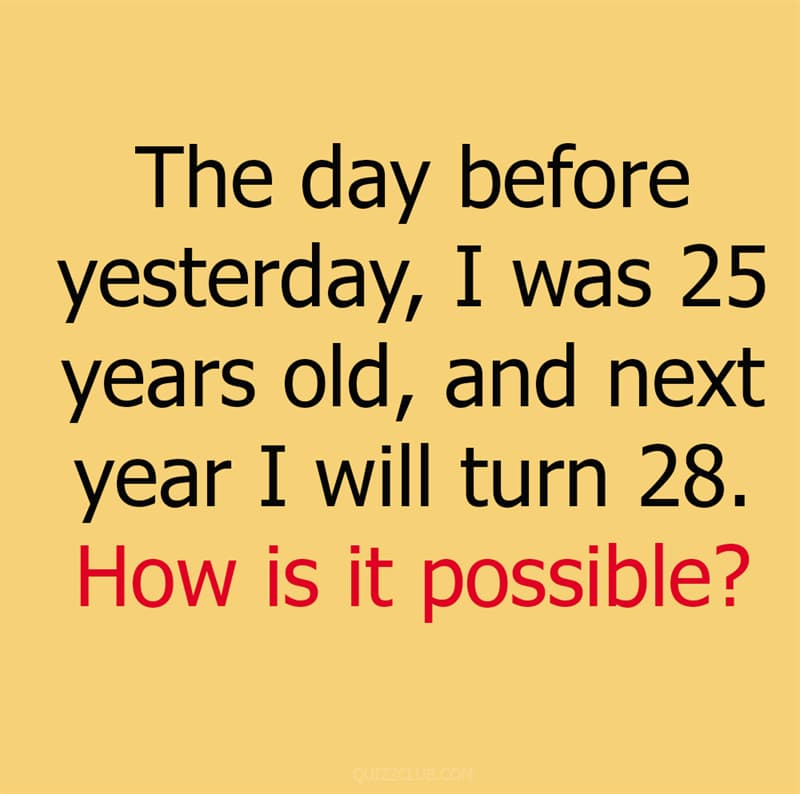Riddles and brain teasers are more than just fun challenges; they’re a fantastic way to keep your brain sharp and your problem-solving skills in top form. Some riddles, however, have a unique twist that throws even the most logical minds for a loop. Today’s riddle is one of those tricky puzzles that plays with time and age in a clever way.
Let’s dive into this riddle and see if you can crack the code:
Riddle: “The day before yesterday, I was 25 years old, and next year, I will turn 28. How is that possible?”

At first glance, this riddle seems impossible. How can someone go from 25 to 28 so quickly? The key is in understanding how specific dates and birthdays work together. Let’s break it down step by step to solve the puzzle.
Breaking Down the Puzzle: Why Is This So Tricky?
Many people get stumped by this riddle because it seems to break the natural flow of time. We are used to thinking of age progression as a straightforward, year-by-year process. If you were 25 yesterday, you should be 26 today, right? However, this riddle cleverly plays with timing, dates, and birthdays.
Here are some common reasons people struggle with solving this riddle:
- Misinterpreting Dates: The phrase “the day before yesterday” can confuse people, making them think in terms of typical age progression.
- Linear Thinking: Most assume age increases annually on the same day, forgetting that specific timing around the birthday can lead to tricky situations.
- Birthday Timing: The riddle relies on the fact that the speaker’s birthday falls at a very specific time, and understanding this is the key to unlocking the answer.
Let’s dig into how to solve this riddle and reveal how it is, in fact, possible.
Understanding “The Day Before Yesterday”
The first clue to solving the riddle lies in the phrase “the day before yesterday.” Let’s make a key assumption: today is January 1st. If today is January 1st, that means the day before yesterday would have been December 30th.
Age on December 30th
According to the riddle, on December 30th, the speaker was still 25 years old. This indicates that their birthday had not yet occurred. So far, this makes sense, but we still have to figure out how the speaker jumps from 25 to 28 in such a short time frame.
The Birthday Factor: December 31st
Here’s where things get interesting. The speaker’s birthday falls on December 31st. So, on December 30th, they were still 25 years old. On December 31st, they celebrated their birthday and turned 26. This solves the first part of the riddle—how the speaker could have been 25 the day before yesterday.
The Progression of Age Over Time
Now that the speaker has turned 26 on December 31st, let’s look at the rest of the riddle.
- Today, on January 1st, the speaker is 26 years old.
- This year, on December 31st, the speaker will turn 27.
- Next year, on December 31st, the speaker will turn 28.
Thus, the statement “next year, I will turn 28” fits perfectly. The riddle plays with the concept of the calendar year and the timing of the speaker’s birthday to create a scenario that seems impossible but is entirely logical.
The Solution Explained
To sum up the solution:
- Today is January 1st.
- The day before yesterday, which was December 30th, the speaker was still 25 years old.
- On December 31st, they turned 26.
- This year, on December 31st, they will turn 27.
- Next year, on December 31st, they will turn 28.
The riddle is tricky because it uses the timing of a birthday at the very end of the year to create a rapid age progression within two calendar years.
Why This Riddle Stumps People
This riddle is difficult because it forces us to think about time and age progression in a non-linear way. Most people assume that age increases steadily each year, but the puzzle plays with the idea that birthdays can occur at specific times, which shifts the timeline.
It’s easy to get caught up in the literal phrasing and assume that something strange or magical is happening. However, by stepping back and thinking about the role of the birthday, we can solve the puzzle using pure logic.
The Beauty of Riddles: Enhancing Logical Thinking
Riddles like this one are more than just entertaining—they sharpen our brains. They encourage us to step outside of our usual thought patterns and consider alternative solutions. When faced with a puzzle that seems impossible at first, the key is often in the small details we overlook.
By challenging our minds to think creatively and logically, riddles help improve problem-solving skills, attention to detail, and critical thinking.
Did You Solve the Riddle?
Now that we’ve broken down the solution, how did you do? Were you able to figure out the riddle on your own, or did it catch you off guard? It’s okay if you didn’t solve it right away—this one’s designed to make you think!
Conclusion: A Fun Challenge for Your Brain
This age-related riddle is a great example of how puzzles can trick our brains into overthinking or misinterpreting simple clues. By playing with time and birthdays, the riddle creates a scenario that feels impossible at first but is actually quite logical once you break it down.
If you enjoyed this riddle, why not share it with friends or family to see if they can solve it? Riddles are not only a fun challenge but also a great way to engage your mind and improve your cognitive skills.
Do you love solving brain teasers like this? Let us know in the comments how quickly you cracked this puzzle and if you want to see more challenges like this in the future. Happy puzzling!


